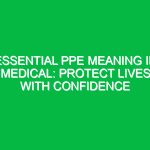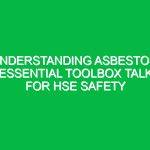Introduction
In today’s fast-paced work Environment, ensuring health, safety, and environmental (HSE) compliance is paramount. The use of a Microsoft Word checklist template is a powerful tool for organizations striving to streamline their HSE processes. These templates provide a structured format for documenting Safety protocols, hazard assessments, and compliance measures, ensuring that nothing crucial is overlooked. This article explores the significance of a Microsoft Word checklist template in the HSE domain, highlighting its components, benefits, and Best Practices.
Understanding Microsoft Word Checklist Templates
A Microsoft Word checklist template is a pre-formatted document that guides users in creating various lists for tasks, inspections, or assessments. In the context of HSE, these templates can be instrumental in managing compliance, conducting risk assessments, and ensuring Safety Measures are consistently applied.
Using a checklist template helps organizations maintain thorough records, which are essential not only for compliance but also for fostering a culture of Safety. By simplifying the process of tracking HSE tasks, these templates can enhance overall efficiency and accountability.
Key Components of a Microsoft Word Checklist Template for HSE
When creating or utilizing a Microsoft Word checklist template for HSE purposes, several key components should be included:
1. Title and Date
Every checklist should start with a clear title indicating its purpose, along with the date it was created or updated. This helps users quickly identify the checklist’s relevance and ensures that the most current information is being utilized.
2. Task Description
Each checklist item should have a brief but descriptive task statement. This clarity allows all users, regardless of their experience level, to understand what is required.
3. Responsibility Assignment
Identifying who is responsible for each task is critical. This accountability ensures that all items are addressed and helps avoid confusion during inspections or audits.
4. Status Indicators
Including options for marking the status of each task—such as “Completed,” “In Progress,” or “Not Started”—provides a quick overview of the checklist’s completion state.
5. Comments Section
A space for comments allows users to provide additional context or note any issues encountered during the assessment or task completion. This can be invaluable for future reference.
6. Signature Line
For added accountability, a signature line for the person completing the checklist can be included. This practice not only verifies that a task was completed but also provides a point of contact for any follow-up questions or issues.
Benefits of Using Microsoft Word Checklist Templates in HSE
The adoption of a checklist template in the HSE context offers numerous advantages:
1. Improved Compliance
Using a checklist helps ensure compliance with HSE Regulations. By systematically working through tasks, organizations can reduce the risk of overlooking essential Safety Measures.
2. Enhanced Communication
Checklists serve as clear communication tools among team members. Everyone involved understands their roles and responsibilities, fostering collaboration and reducing misunderstandings.
3. Consistency in Processes
Templates promote consistency in how HSE tasks are performed. This uniformity helps organizations establish standardized practices that can be replicated across different teams and projects.
4. Efficient Record-Keeping
Checklists create an accessible record of compliance and safety measures taken. This documentation is vital during audits or inspections, providing evidence of due diligence.
5. Risk Mitigation
By systematically identifying Hazards and risks through checklists, organizations can proactively address potential issues before they escalate into serious problems.
Best Practices for Creating Effective HSE Checklists
To maximize the effectiveness of Microsoft Word checklist templates, consider the following Best Practices:
1. Customize for Specific Needs
While templates provide a great starting point, customization is key. Tailor your checklist to fit the specific requirements of your organization or industry, ensuring it addresses relevant Hazards and compliance measures.
2. Regularly Update the Checklist
HSE regulations and Standards evolve, making it essential to keep checklists current. Regular reviews and updates ensure that all items reflect the latest safety protocols and legal requirements.
3. Train Staff on Usage
Ensure that all team members are trained on how to use the checklist effectively. Provide examples and scenarios that illustrate its importance in promoting safety and compliance.
4. Utilize Technology
While Microsoft Word is a powerful tool, consider integrating your checklist with other software or digital platforms for enhanced functionality. Digital tools can provide real-time updates, easier sharing, and even automated reminders for task completion.
5. Gather Feedback for Improvement
After using the checklist, solicit feedback from team members. Their insights can help refine the template and improve its effectiveness in real-world applications.
Potential Hazards and Risks in HSE Checklists
While checklists can greatly enhance safety, it’s vital to recognize potential pitfalls. Some common issues include:
1. Overlooking Critical Items
If the checklist is too generic or not well-tailored to specific tasks, critical safety measures may be overlooked, increasing the risk of accidents.
2. Incomplete Documentation
Failing to provide sufficient space for comments or updates can lead to incomplete records, making it difficult to track past issues or improvements.
3. Resistance to Change
Employees may resist using new checklists or templates, particularly if they are accustomed to previous methods. Addressing this resistance through communication and Training is essential.
Regulations and Standards Impacting HSE Checklists
Understanding the regulatory landscape is vital for creating effective HSE checklists. Various organizations and governing bodies set standards that influence how checklists should be structured and utilized:
1. OSHA Standards
The Occupational Safety and Health Administration (osha) provides regulations that affect Workplace Safety practices. Checklists should align with OSHA standards to ensure compliance and mitigate risks.
2. ISO Standards
The International Organization for Standardization (ISO) offers standards related to environmental management (ISO 14001) and health and safety (ISO 45001). Incorporating these standards into checklists can enhance organizational credibility and safety practices.
3. Local Regulations
Many regions have specific HSE regulations that must be adhered to. Regularly reviewing local laws ensures that checklists remain compliant and relevant.
Conclusion
In conclusion, a Microsoft Word checklist template is an invaluable resource for organizations committed to health, safety, and environmental compliance. By providing a structured approach to managing safety tasks and responsibilities, these templates foster a culture of accountability and diligence.
The importance of HSE cannot be overstated, as it directly impacts employee well-being and organizational Sustainability. Therefore, investing time in creating, using, and regularly updating checklist templates is essential for success in any industry. By embracing these tools, organizations can not only meet regulatory requirements but also cultivate a safer and more productive work environment.
Ultimately, the journey towards HSE excellence begins with the simple act of checking off tasks, ensuring that safety remains at the forefront of every operational decision.


